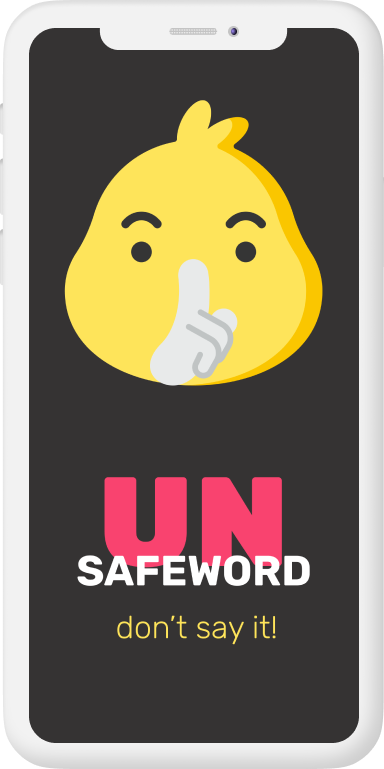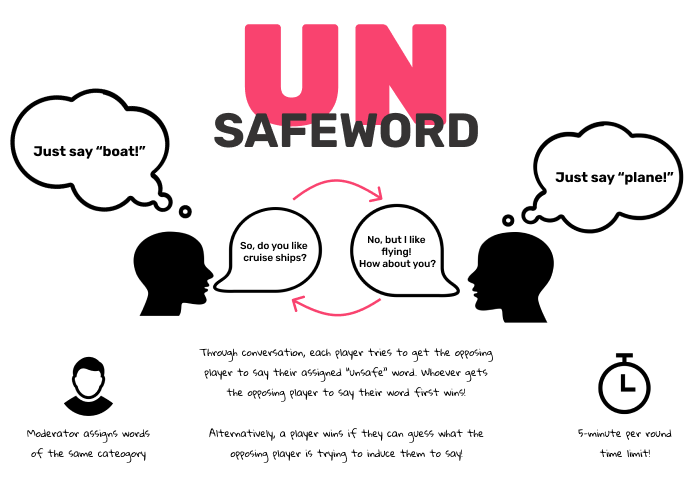Artist’s Statement
For our social game we wanted to create something simple that allows a player to have fun navigating a tricky challenge, while also engaging with other players on a personal level. This meant coming up with a relatively uncomplicated set of rules that would not encumber the players’ exchanges but would be challenging enough to keep the players hooked. (UN)SAFEWORD was the result.
When playing (UN)SAFEWORD two players have a regular conversation with one caveat: you are trying to trick the other player to say an assigned word, while they do the same, in order to win. This simple configuration results in a game where the players pay very close attention to every word their opponent says, which makes for a great get-to-know-you game and the antithesis of passive conversation. Players must strategize about how they can unseemingly trick their opponent, while also multitasking a casual conversation, and trying to decipher and avoid their opponent’s word.
As we hoped, the resulting in-game conversations are often silly and goofy, but rarely unengaging. Players have a wide range of strategies they can adopt to fit their playstyle, and often leave the game feeling like they learned something new about their opponent in a fun and entertaining way.
Ideation

When brainstorming game ideas, we each brainstormed ideas onto post-its on Mural. After generating ideas, we grouped the post-its into broad categories based on relatedness. Then, we each voted with a sticker our top three favorite ideas and finally chose the “get the opponent to say a word” idea as our favorite of the bunch.
Concept Map
Final Prototype
Creating Fun Through Formal Elements
For (UN)SAFEWORD, we have a player-vs-player interaction pattern, wherein both players engage in a conversation. Through this interaction pattern, we believe (UN)SAFEWORD helps in achieving a one-on-one social fellowship type of fun, since both players are encouraged to enter into a lively social interaction with each other in order to play. Not only do they find out interesting things about each other, the rules of the game put them in funny situations. Players will often find themselves making humorous attempts to avoid a word because they can’t say it. Alternatively, they might take a bold step and guess the other player’s word. This risky all-or-nothing move can create suspense and comic relief, which are core aspects of a game that fosters social bonding.
Our game’s rules and it’s time-constrained objectives also introduce another kind of fun: challenge. Since players can’t use their own word or any of its forms (e.g. tenses) in their attempt to get the other player to say it, they have to utilize strategic thinking and good conversational skills (the main resources they have as a player) to trick the other person. In our playtests, we often saw players throw red-herrings into the conversational mix to deceive the other player into focusing on the wrong word. Once their guard was down, they would have them stumble onto the right word without even noticing. Therefore, the game’s simple rules constantly have both players forming and revising strategies for tricking the other player while also not getting deceived themselves. Focusing on these two things simultaneously is what starts to make the game challenging.
Furthermore, what adds to the challenge is the 5-minute time-limit for a round. Without such a limit, a potential strategy would be to simply stall the game and force a draw. By adding the time-limit, we make sure the pace of the game is not too slow and the game doesn’t get boring by encouraging both players to try to be aggressive and active in trying to trick the opponent. This sense of urgency gives the game a more dynamic feel. On the other hand, to counteract recklessly aggressive players, we give players one chance to guess the opponent’s word. That is, if a player makes it too obvious what their word is, they can be punished by their opponent, which forces a player to be careful about how forcefully they try to trick their opponent, resulting in more subtle game play. Moreover, we decided that one guess would be enough to achieve this goal rather than several, as numerous guesses could lead to the opposite of what we want: more reckless gameplay with players just chucking out haphazard guesses to see if they get lucky. These two factors put together make the game fast-paced enough to not be boring, but difficult enough to force players to make astute plays.
Core Loops & Arcs
Our game relies on the intrinsic looping nature of a conversation to work. Any organic conversation between two people can be broken down into a cycle of back-and-forth question-and-answers. Therefore, by figuring out how to frame their questions to lure the other player into saying their word, or how to answer questions whilst avoiding the (UN)SAFEWORD, players learn how to play our game well. This gradual building towards mastery is the objective of any game loop. Additionally, the overall conversations in our games also aim to achieve a natural story arc. Players tell each other things about themselves to build a small narrative, which gets deeper and deeper as the round goes on.
Designs



Playtests and Iteration
We playtested our game in class with peers familiar with the foundations of game design and with our friends outside of class. The following are learnings we derived from playtests conducted in class:
Playtest Round 1 (Tuesday, April 13)
Observations:
While the players seemed to be having a lot of fun trying to deceive the other player, the first playtest lasted a very long time. We assigned each player a completely random word (“relative” and “doctor”). As a result, the conversation would swing back and forth between the two players, with each completely shifting the conversation towards their word at each turn. This would result in very unnatural changes in conversation topics. This made it difficult to pin down exactly what the unsafe words were, but easy to identify the general subject area/topic surrounding the unsafe words. Consequently, once players already determined which words were “safe” to use, it was easy to continue carrying on the conversation using just those known safe words and evading any potential unsafe words. The game dragged on for over 10 minutes of circumlocution.
Thoughts:
Although this was still comical and fun for the players and moderator, it was frustrating that it didn’t seem like the game was going anywhere after players stuck to the known safe words. We also wanted to prevent players from abusing the game by ignoring the topic that the player was trying to get them to talk about.
Recommendations:
- We made the rule that the moderator would have to pick two “random” words that had some relatedness like “plane” and “boat.” We made this decision due to the following reasons: 1) To narrow the scope so that the conversation could stay in the same realm, 2) To help make the game move along faster,
- To further speed up the game, we added the rule that if a player could guess the unsafe word the opponent was attempting to make them say, then this would result in a win for the player. Each player could only take a guess at the unsafe word, and if it was incorrect, it was “instant death.”
Playtest Round 2 (Thursday, April 15)
Observations:
Because the unsafe words were related to each other by theme (i.e. “clinic” and “hospital”), the conversations flowed much more naturally. The players weren’t as frustrated because the topic never strayed far from their words. Additionally, these rounds went much faster (averaged around 2-3 minutes) and did not have the feel of dragging on. However, because of the instant death from incorrect unsafe word guess rule, the players were hesitant to take any guesses at all.
Thoughts:
During an exit interview, the players in this modification stated that they experienced a sense of paranoia over saying the other person’s word since they might accidentally say it while on the topic of their own word. However, this also enabled them to deduce what the other player’s word was based on their own, which added strategy to the game.This seemed to be a significant improvement from the previous iteration where the player could easily avoid the entire topic that the other player was interested in.
Recommendations:
- To address the hesitancy to guess the unsafe word, we revised the rule to allow for three guesses before losing the game.
- Additionally, after feeling like we had nailed down the core of our game, we started thinking more about edge cases that could occur and the best ways to prevent them. Firstly, we codified the rule that all players needed to engage in the spirit of the conversation (rather than simply give one-word responses to their opponents’ attempts at conversation).
- To ensure that games did not go on for too long, we incorporated a hard 5-minute time limit. If players met this time limit, they would each get a final guess at the unsafe words before the game ended.
Playtest Round 3 (Tuesday, April 20)
Observations:
Most of the games ended extremely quickly with players guessing the unsafe words, as the conversations were quite rapid-fire and players barely hesitated before guessing the unsafe words. In our last playtest, the two players actually reached this time limit which shows its usefulness.
Thoughts:
The aggressive play-style of the participants contributed to the initial quick games. However, the relatively high three-guess limit for guessing the unsafe words seemed to reduce most of the players’ inhibitions when it came to guessing the unsafe words. That said, the relative success of this round of playtesting gave us more space to consider additional aspects of the game, such as the moderator’s role (which is essential for this game). In all playtesting rounds so far, members of our project team had served as the moderator. However, we were concerned that future non-game designer moderators would be bored during the game, which we brought up in Checkpoint 2 of this project.
Recommendations:
- We changed the number of guesses each player had for determining the unsafe words back from 3 to 1 in order to reduce the aggressiveness of the players and lengthen the duration of each round. Because we now had a 5-minute time limit and only one shot at guessing, our game now had a new, fun tension; players were now encouraged to make a guess before the time ran out in order to increase their chances of winning the game, but also not to guess before collecting enough information about the unsafe word.
- We decided to have the moderator rotate every round, following Christina’s advice. Given that the rounds are at most 5 minutes, no one would be out of commission for long enough to get bored during the game.




